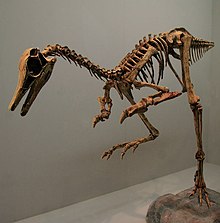Alvarezsauroidea
It has been suggested that Alvarezsauridae be merged into this article. (Discuss) Proposed since April 2024. |
| Alvarezsauroids | |
|---|---|

| |
| Skeletal mount of Patagonykus | |
| Scientific classification | |
| Domain: | Eukaryota |
| Kingdom: | Animalia |
| Phylum: | Chordata |
| Clade: | Dinosauria |
| Clade: | Saurischia |
| Clade: | Theropoda |
| Clade: | Maniraptora |
| Clade: | †Alvarezsauria Bonaparte, 1991 |
| Superfamily: | †Alvarezsauroidea Bonaparte, 1991 |
| Type species | |
| † Alvarezsaurus calvoi Bonaparte, 1991
| |
| Subgroups | |
Alvarezsauroidea is a group of small maniraptoran dinosaurs. Alvarezsauroidea, Alvarezsauridae, and Alvarezsauria are named for the historian Gregorio Álvarez, not the more familiar physicist Luis Alvarez, or his son geologist Walter Alvarez who jointly proposed that the Cretaceous–Paleogene extinction event was caused by an impact event. The group was first formally proposed by Choiniere and colleagues in 2010, to contain the family Alvarezsauridae and non-alvarezsaurid alvarezsauroids, such as Haplocheirus,[1] which is the basalmost of the Alvarezsauroidea (from the Late Jurassic, Asia). The discovery of Haplocheirus extended the stratigraphic evidence for the group Alvarezsauroidea about 63 million years further in the past. The division of Alvarezsauroidea into the Alvarezsauridae and the non-alvarezsaurid alvarezsauroids is based on differences in their morphology, especially in their hand morphology.
Introduction
The first fossil alvarezsauroids were recognized in the 1990s. Since then, the number of specimens found has dramatically increased. Most of the recent alvarezsauroids are found in China, but they are also known from the Americas and Europe.
The size[specify] of the derived members of Alvarezsauroidea range between 0.5 and 2 m (1 ft 8 in and 6 ft 7 in), but some members may have been larger.[2] Haplocheirus, for example, was the largest member of the Alvarezsauroidea. Because of the size of Haplocheirus and its basal phylogenetic position, a pattern of miniaturization for the Alvarezsauroidea is suggested. Miniaturizations are very rare in dinosaurs, but convergently evolved in Paraves.[1]
Classification
The phylogenetic placement of Alvarezsauroidea is still unclear. At first, they were interpreted as a sister group of
The cladogram below is based on Choniere et al. (2010).[1]
| Alvarezsauroidea |
| ||||||||||||
Geographical distribution
At first, alvarezsauroids were thought to have been originated in
Hand morphology
The differences in the morphology of the hand of basic Alvarezsauroidea and the derived members are characterized by digit reduction. In the evolution of

References
- ^ PMID 20110503
- ^ Hutchinson, Chiappe (1998). "The first known alvarezsaurid (Theropoda: Aves) from North America". "Journal of Vertebrate Paleontology". 18(3): 447-450.
- ^
- ^ ISBN 978-0-375-82419-7.
- ^ Xu, X., Upchurch, P., Ma, Q., Pittman, M., Choiniere, J., Sullivan, C., Hone, D.W.E., Tan, Q., Tan, L., Xiao, D., and Han, F., 2013. Osteology of the Late Cretaceous alvarezsauroid Linhenykus monodactylus from China and comments on alvarezsauroid biogeography. Acta Palaeontologica Polonica 58 (1): 25–46.
- S2CID 247391327.
- ^ Averianov A, Sues H-D (2017) The oldest record of Alvarezsauridae (Dinosauria: Theropoda) in the Northern Hemisphere. PLoS ONE12(10): e0186254. https://doi.org/10.1371/journal.pone.0186254
- .
Sources
- Nesbitt, S.J., Clarke, J.A., Turner, A.H., Norell, M.A. (2011): "A small alvarezsauroid from eastern Gobi Desert offers insight into evolutionary patterns in the Alvarezsauroidea". Journal of Vertebrate Paleontology. 31:1. 144–153.
- Turner, A.H., Nesbit, S.J., Norell, M.A. (2009): "A Large Alvarezsaurid from the Late Cretaceous of Mongolia". American Museum Novitates. Number: 3648.
- Bonaparte, J.F. (1991). "Los vertebrados fosiles de la formacion Rio Colorado, de la ciudad de Neuquen y Cercanias, Creatcio Superior, Argentina" Rev. Mus. Agent. Cienc. "Bernardino Rivadavia", Paleontol. 4:16-123.
- Choiniere, J. (2010). Guest Post: Haplocheirus, the Skillful One Dave Hone's Archosaur Musings, April 23, 2011

